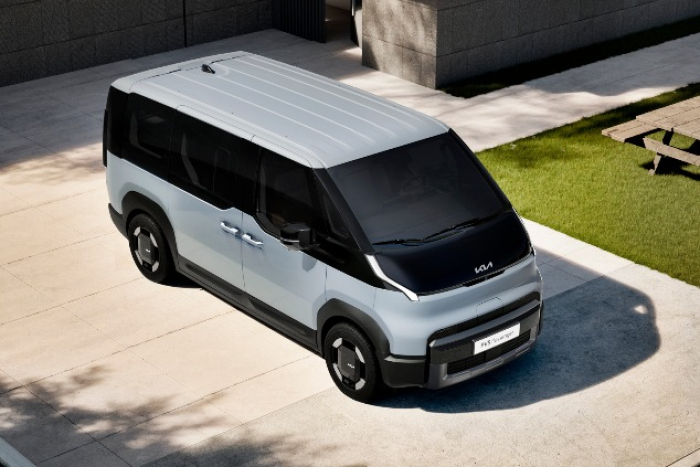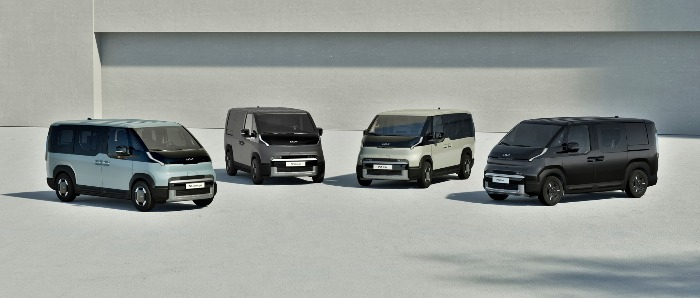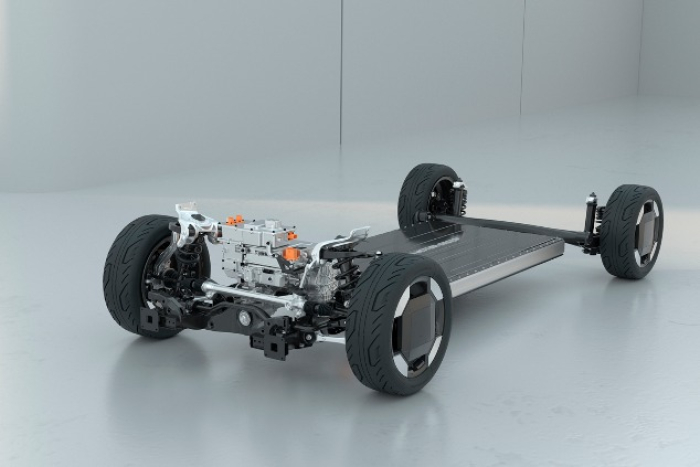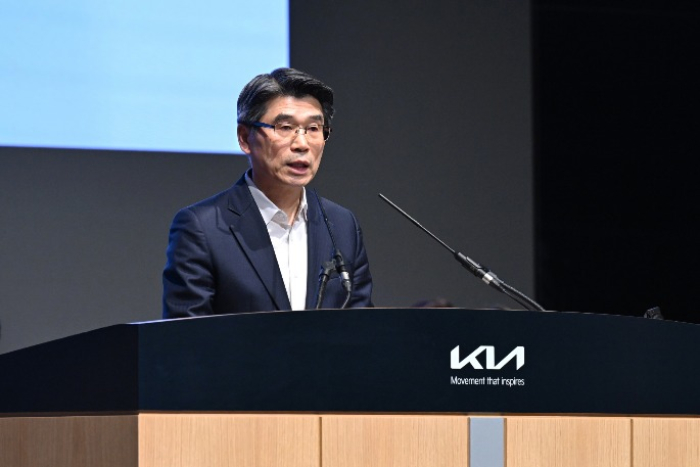Kia to release PV9 in 2029, retains CEO for 3 more years
South Korea’s second-largest carmaker unveiled the launch year of the new PBV model, PV9, for the first time
By Mar 14, 2025 (Gmt+09:00)
LG Chem to sell water filter business to Glenwood PE for $692 million


KT&G eyes overseas M&A after rejecting activist fund's offer


Kyobo Life poised to buy Japan’s SBI Group-owned savings bank


StockX in merger talks with Naver’s online reseller Kream


Meritz backs half of ex-manager’s $210 mn hedge fund



Kia Corp. will release a new purpose-built vehicle (PBV) model every two years, with plans to launch the PV9 in 2029 and its first model, the PV5, this year to drive future growth with PBVs alongside its electrification and software-centered mobility transition.
South Korea’s second-largest automaker after its bigger sibling Hyundai Motor Co. will release the PV5 in 2025, the PV7 in 2027 and the PV9 in 2029 in phases, Kia’s PBV Division Head Kim Sangdae said at the company’s annual shareholders’ meeting on Friday.
It is the first time that Kia has unveiled the release plan of the PV9, which is presumed to be its flagship PBV.
Previously, the carmaker heralded the launch of the PV5 in 2025, followed by the PV7 and the PV1.
With the three models – the PV5, the PV7 and the PV9 – the Korean carmaker targets selling 250,000 units of PBVs by 2030, Kim said.
BETTING BIG ON PBVs, ALONGSIDE EVs
Kia’s PBV business is integral to its future mobility strategy, dubbed Plan S, a plan for a shift toward future mobility, alongside electric vehicles.

The company expects PBVs to account for about a quarter of its cars sold globally by 2030, with an ambition to become the world’s top PBV player.
The company describes PBVs as individually tailored vehicles built with customized interior and exterior designs and different specifications to meet personalized driving purposes.
The market for personalized vehicles has huge growth potential as such cars can be used for various purposes, such as public transportation, clinics, cafes, living space and freight transfer, the company said.
In early February, Kia debuted its first PBV, the PV5, at 2025 Kia EV Day held in Tarragona, Spain, signaling its full-scale entry into the electric light commercial vehicle (LCV) market.

Kia said its PV5 aims to challenge the Ford Transit and Renault Kangoo in the LCV market, which is forecast to grow to 4 million units globally by 2030.
The PV5 is built on Kia’s dedicated E-GMP.S platform, a scalable skateboard platform that allows for various vehicle configurations.
The Kia PV5, a modular vehicle, will come in various versions, including the PV5 High Roof, PV5 Van, PV5 Chassis Cab, PV5 robotaxi and PV5 Pickup.
ROSY FUTURE AHEAD UNDER CEO SONG
At the shareholders' meeting, Hyundai Motor Group’s Executive Chair Chung Euisun and Kia Chief Executive Song Ho-sung were reappointed as inside directors.
Song, who took the helm of the carmaker in mid-June 2020, will lead Kia for another three years. Under his direction, Kia has grown significantly in terms of global car sales with an improved brand awareness following a corporate rebranding in early 2021.

Kia reported a record of 107.45 trillion won ($73.8 billion) in annual sales in 2024, breaking the 100 trillion won mark for the first time since its inception about 70 years ago, thanks to brisk sales of green cars and premium sport utility cars worldwide.
The carmaker also logged 11.8% in annual profit margin, becoming the highest earner per vehicle sold above its global rivals such as Tesla, Toyota Motor, Mercedes-Benz, BMW and Volkswagen as well as its sister firm Hyundai Motor in terms of profitability.
“Kia will strive to sustain its growth streak by making EVs more accessible, fostering new growth engines, such as PBVs and pickup trucks, achieving software-centered transition and acquiring future mobility technologies,” CEO Song said at the annual shareholders meeting.
The company has set a target to produce 3.22 million vehicles in 2025, 130,000 units more than 2024.
Chairman Chung, who has been an inside board director for Hyundai Motor, Kia and Hyundai Mobis Co., will receive a salary from Kia starting this year after shareholders approved a proposal to bump up directors’ salaries this year.
Chung has so far only been paid by Hyundai Motor and Hyundai Mobis, not Kia.
He earned 11.5 billion won in total annual salary in 2024 versus 12.2 billion won in 2023.
Write to Jung-Eun Shin at newyearis@hankyung.com
Sookyung Seo edited this article.
-
 Electric vehiclesKia CEO stands firm on electrification strategy, premieres EV4 in Europe
Electric vehiclesKia CEO stands firm on electrification strategy, premieres EV4 in EuropeFeb 27, 2025 (Gmt+09:00)
4 Min read -
 EarningsKia hits record 2024 sales; profit margins highest among global automakers
EarningsKia hits record 2024 sales; profit margins highest among global automakersJan 24, 2025 (Gmt+09:00)
3 Min read -
 Korean innovators at CES 2024Kia, Uber to jointly develop custom-tailored electric ride-hailing PBV
Korean innovators at CES 2024Kia, Uber to jointly develop custom-tailored electric ride-hailing PBVJan 11, 2024 (Gmt+09:00)
2 Min read -
 Korean innovators at CES 2024Kia to launch mid-sized purpose-built vehicle PV5 in 2025
Korean innovators at CES 2024Kia to launch mid-sized purpose-built vehicle PV5 in 2025Jan 09, 2024 (Gmt+09:00)
3 Min read -
 Electric vehiclesKia to build 2nd purpose-built vehicle plant in Korea
Electric vehiclesKia to build 2nd purpose-built vehicle plant in KoreaOct 13, 2023 (Gmt+09:00)
3 Min read -
 AutomobilesHyundai to spend $18 bn on EVs; Kia breaks ground on first PBV plant
AutomobilesHyundai to spend $18 bn on EVs; Kia breaks ground on first PBV plantApr 11, 2023 (Gmt+09:00)
3 Min read -
 AutomobilesHyundai Group unveils purpose-built vehicle for airport pickup
AutomobilesHyundai Group unveils purpose-built vehicle for airport pickupSep 19, 2022 (Gmt+09:00)
1 Min read -
 AutomobilesKia set to break ground on purpose-built vehicle plant in 2023
AutomobilesKia set to break ground on purpose-built vehicle plant in 2023Mar 30, 2022 (Gmt+09:00)
2 Min read -
 Corporate rebrandKia drops Motors from name, unveils roadmap for new EV models
Corporate rebrandKia drops Motors from name, unveils roadmap for new EV modelsJan 15, 2021 (Gmt+09:00)
2 Min read -
 Chief ExecutivesKia aims to become purpose-built vehicle market leader: CEO
Chief ExecutivesKia aims to become purpose-built vehicle market leader: CEOFeb 02, 2021 (Gmt+09:00)
4 Min read


